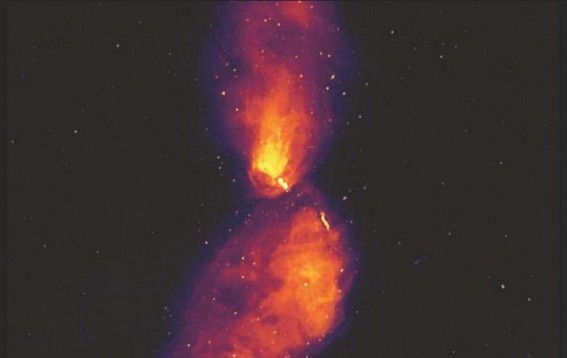TIWN

Sydney, Dec 23 (TIWN) Astronomers from Curtin University, as part of an international team, have produced the most comprehensive images of the nearest active black hole to earth.
According to astronomers, the image is caused from the black hole feeding on in-falling gas and then ejecting most of the material at near light-speed on either side of the hole, causing "radio bubbles" to grow over "hundreds of millions of years."
When viewed from Earth, scientists note that the Centaurus A eruption extends eight degrees across the sky -- the length of 16 full moons laid side-by-side, they say. The research was published Wednesday in peer-reviewed journal Nature Astronomy. Lead author of the research, Benjamin McKinley from the Curtin University juncture of the ICRAR, said the new image reveals "spectacular" details of the radio emission from the galaxy. "Previous radio observations could not handle the extreme brightness of the jets and details of the larger area surrounding the galaxy were distorted, but our new image overcomes these limitations," McKinley said in a press release.
McKinley noted that the image offers astronomers new insights into the Centaurus A, specifically around its radio wavelengths and other wavelengths of light. "In this research we’ve been able to combine the radio observations with optical and X-ray data, to help us better understand the physics of these supermassive black holes," he said. Massimo Gaspari, of Italy’s National Institute for Astrophysics, said in the release that the study corroborates a "novel theory" known to astronomers as 'Chaotic Cold Accretion' (CCA). "In this model, clouds of cold gas condense in the galactic halo and rain down onto the central regions, feeding the supermassive black hole," Gaspari explained. "Triggered by this rain, the black hole vigorously reacts by launching energy back via radio jets that inflate the spectacular lobes we see in the MWA image."
Gaspari says this study is "one of the first to probe in such detail the multi-phase CCA 'weather' over the full range of scales."
- The death toll in Iran's government crackdown is feared to be as high as 20,000
- Kazakhstan Seeks US and European Help Securing Oil Transport
- Trump's DOJ Probes Raise Concerns of Political Motivations
- Denmark and Greenland in High-Stakes Meeting with US Over Island Control
- Iran Warns Neighbors of Potential US Base Attacks



